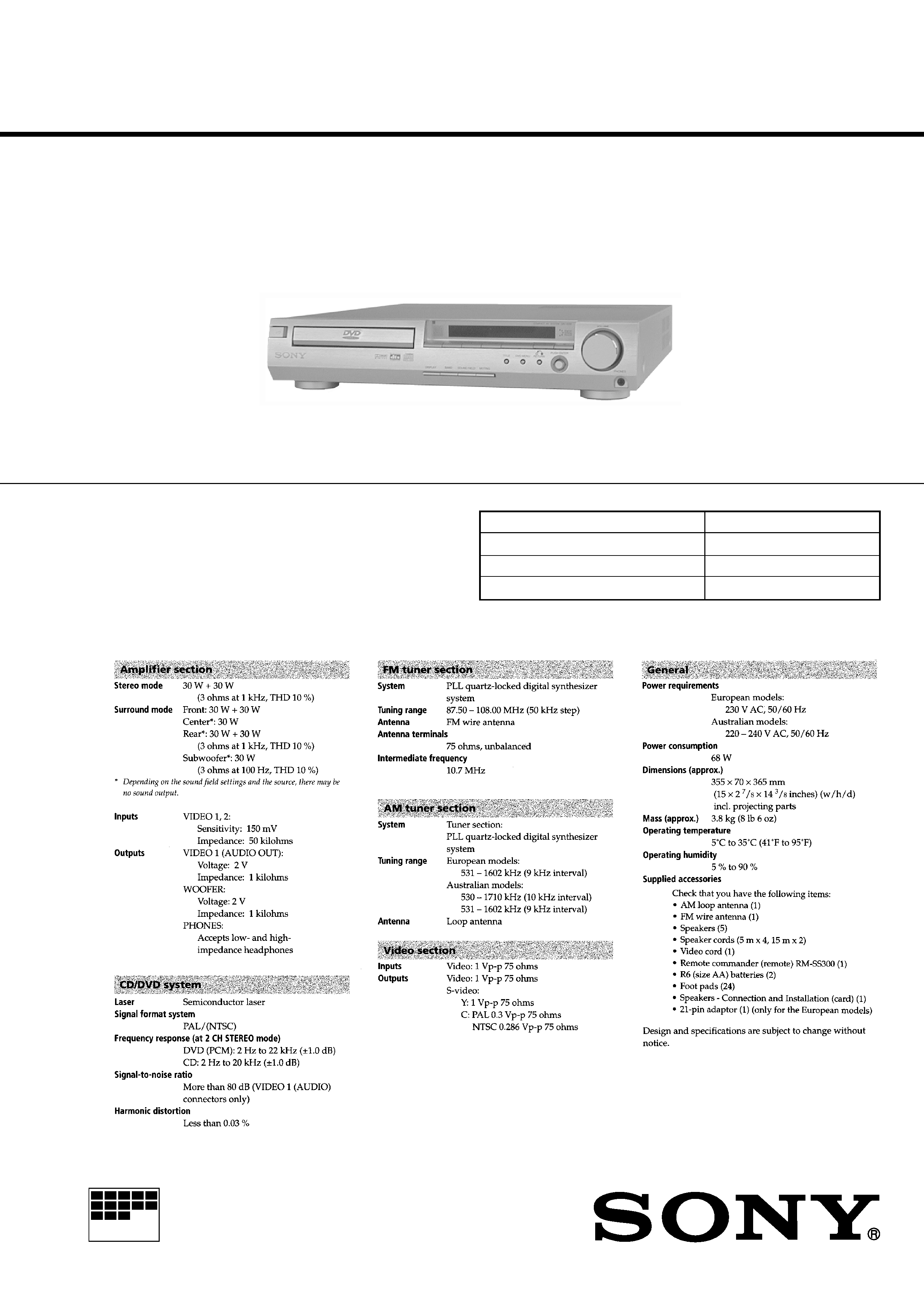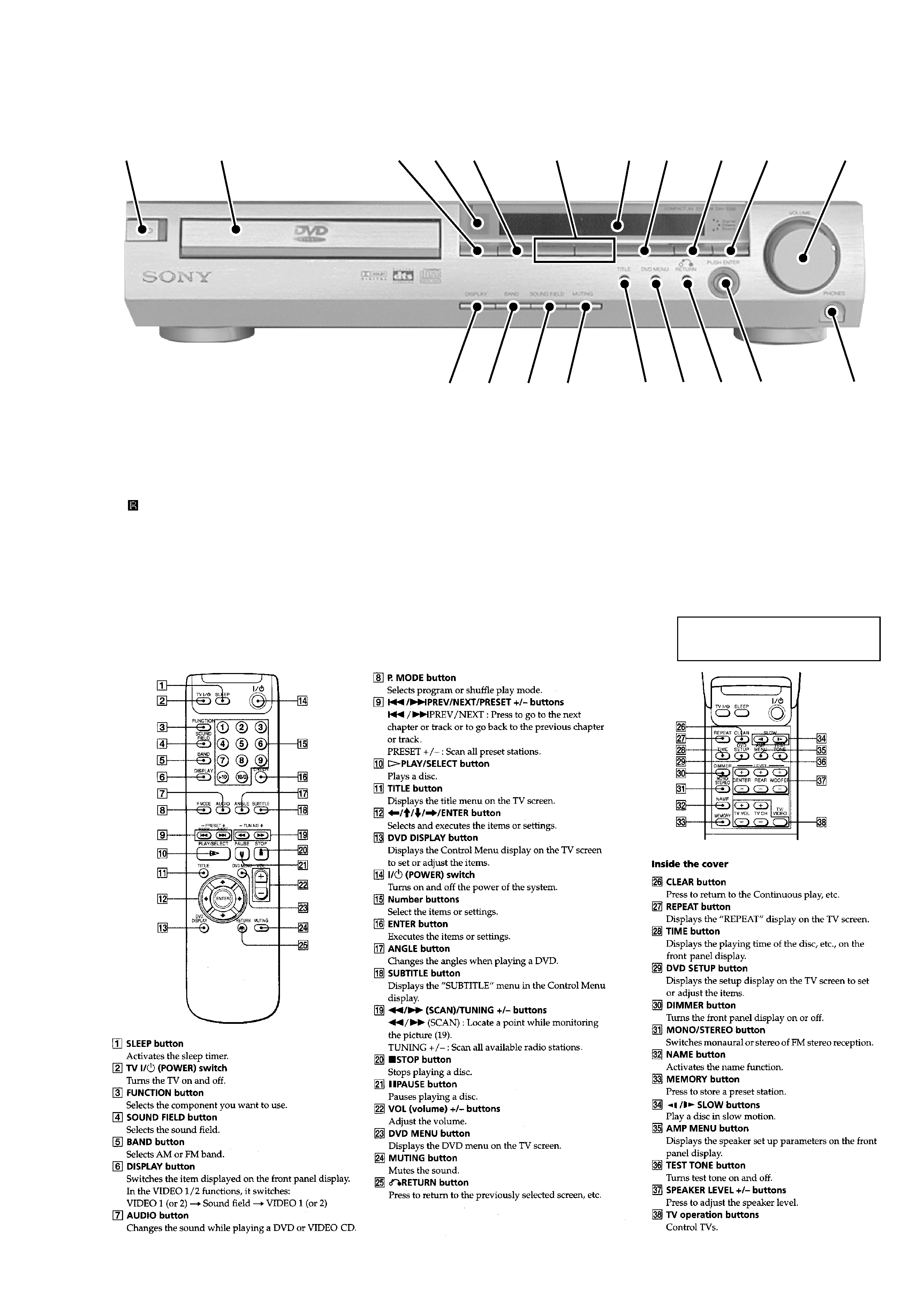
1
HCD-S300
US Model
AEP Model
UK Model
E Model
Australian Model
Chinese Model
COMPACT AV SYSTEM
MICROFILM
SERVICE MANUAL
SPECIFICATIONS
Model Name Using Similar Mechanism NEW
Mechanism Type
CDM-55D-DVBU2
Base Unit Type
DVBU2
Optical Pick-up Type
KHM220AAA/CINP1
HCD-S300 is the amplifier, DVD/CD and
tuner section in DAV-S300.

2
SAFETY CHECK-OUT
After correcting the original service problem, perform the follow-
ing safety checks before releasing the set to the customer:
Check the antenna terminals, metal trim, "metallized" knobs, screws,
and all other exposed metal parts for AC leakage. Check leakage as
described below.
LEAKAGE
The AC leakage from any exposed metal part to earth Ground and
from all exposed metal parts to any exposed metal part having a
return to chassis, must not exceed 0.5 mA (500 microampers). Leak-
age current can be measured by any one of three methods.
1. A commercial leakage tester, such as the Simpson 229 or RCA
WT-540A. Follow the manufacturers' instructions to use these
instruments.
2. A battery-operated AC milliammeter. The Data Precision 245
digital multimeter is suitable for this job.
3. Measuring the voltage drop across a resistor by means of a VOM
or battery-operated AC voltmeter. The "limit" indication is 0.75
V, so analog meters must have an accurate low-voltage scale.
The Simpson 250 and Sanwa SH-63Trd are examples of a pas-
sive VOM that is suitable. Nearly all battery operated digital
multimeters that have a 2V AC range are suitable. (See Fig. A)
Fig. A. Using an AC voltmeter to check AC leakage.
0.15
µF
To Exposed Metal
Parts on Set
1.5k
AC
voltmeter
(0.75V)
Earth Ground
SAFETY-RELATED COMPONENT WARNING !!
COMPONENTS IDENTIFIED BY MARK 0 OR DOTTED LINE
WITH MARK 0 ON THE SCHEMATIC DIAGRAMS AND IN
THE PARTS LIST ARE CRITICAL TO SAFE OPERATION.
REPLACE THESE COMPONENTS WITH SONY PARTS
WHOSE PART NUMBERS APPEAR AS SHOWN IN THIS
MANUAL OR IN SUPPLEMENTS PUBLISHED BY SONY.
CAUTION
Use of controls or adjustments or performance of procedures
other than those specified herein may result in hazardous ra-
diation exposure.
Notes on chip component replacement
· Never reuse a disconnected chip component.
· Notice that the minus side of a tantalum capacitor may be
damaged by heat.
Flexible Circuit Board Repairing
· Keep the temperature of soldering iron around 270°C
during repairing.
· Do not touch the soldering iron on the same conductor of the
circuit board (within 3 times).
· Be careful not to apply force on the conductor when soldering
or unsoldering.
Laser component in this product is capable of emitting radiation
exceeding the limit for Class 1.
This appliance is classified as
a CLASS 1 LASER product.
The CLASS 1 LASER PROD-
UCT MARKING is located on
the rear exterior.
This caution
label is located
inside the unit.

3
NOTES ON HANDLING THE OPTICAL PICK-UP BLOCK
OR BASE UNIT
The laser diode in the optical pick-up block may suffer electrostatic
break-down because of the potential difference generated by the
charged electrostatic load, etc. on clothing and the human body.
During repair, pay attention to electrostatic break-down and also
use the procedure in the printed matter which is included in the
repair parts.
The flexible board is easily damaged and should be handled with
care.
NOTES ON LASER DIODE EMISSION CHECK
The laser beam on this model is concentrated so as to be focused on
the disc reflective surface by the objective lens in the optical pick-
up block. Therefore, when checking the laser diode emission, ob-
serve from more than 30 cm away from the objective lens.
LASER DIODE AND FOCUS SEARCH OPERATION
CHECK
Carry out the "S curve check" in "CD section adjustment" and check
that the S curve waveform is output several times.
1. SERVICING NOTE .......................................................... 4
2. GENERAL .......................................................................... 5
3. DISASSEMBLY
3-1. Loading Panel ...................................................................... 6
3-2. Front Panel ........................................................................... 6
3-3. CD Mechanism .................................................................... 7
3-4. Disc Tray .............................................................................. 7
4. TEST MODE ....................................................................... 8
5. ELECTRICAL ADJUSTMENT ................................. 18
6. DIAGRAMS
6-1. Circuit Boards Location ..................................................... 19
6-2. Block Diagrams ................................................................. 21
· RF/Servo Section ............................................................ 21
· Main Section ................................................................... 22
· Signal Process/Video Section ......................................... 23
· Audio Main Section ........................................................ 24
· I/O, Tuner Section .......................................................... 25
· AMP Section ................................................................... 26
· Display Section ............................................................... 26
· Power Section ................................................................. 27
6-3. Printed Wiring Board TK Section ................................ 28
6-4. Schematic Diagram TK Section .................................. 29
6-5. Printed Wiring Board DVD Section ............................ 30
6-6. Schematic Diagram DVD (1/12) Section .................... 32
6-7. Schematic Diagram DVD (2/12) Section .................... 33
6-8. Schematic Diagram DVD (3/12) Section .................... 34
6-9. Schematic Diagram DVD (4/12) Section .................... 35
6-10. Schematic Diagram DVD (5/12) Section .................... 36
6-11. Schematic Diagram DVD (6/12) Section .................... 37
6-12. Schematic Diagram DVD (7/12) Section .................... 38
6-13. Schematic Diagram DVD (8/12) Section .................... 39
6-14. Schematic Diagram DVD (9/12) Section .................... 40
6-15. Schematic Diagram DVD (10/12) Section .................. 41
6-16. Schematic Diagram DVD (11/12) Section .................. 42
6-17. Schematic Diagram DVD (12/12) Section .................. 43
6-18. Schematic Diagram FRONT (1/2) Section ................. 44
6-19. Printed Wiring Board FRONT (1/2) Section .............. 45
6-20. Schematic Diagram FRONT (2/2) Section ................. 46
6-21. Printed Wiring Board FRONT (2/2) Section .............. 47
6-22. Schematic Diagram VIDEO Section ........................... 48
6-23. Printed Wiring Board VIDEO Section ......................... 49
6-24. Schematic Diagram AUDIO Section ........................... 50
6-25. Printed Wiring Board AUDIO Section ........................ 51
6-26. Schematic Diagram PROTECT Section ...................... 52
6-27. Printed Wiring Board PROTECT Section ................... 53
6-28. Printed Wiring Board POWER (US only) Section ...... 54
6-29. Printed Wiring Board
POWER (AEP, UK, SP, HK, E32, AUS only) Section .. 56
6-30. Schematic Diagram POWER (1/4) Section ................. 58
6-31. Schematic Diagram POWER (2/4) Section ................. 59
6-32. Schematic Diagram POWER (3/4) Section ................. 60
6-33. Schematic Diagram POWER (4/4) Section ................. 61
6-34. Schematic Diagram LOADING Section ..................... 62
6-35. Printed Wiring Board LOADING Section ................... 62
6-36. IC Block Diagrams ............................................................ 63
6-37. IC Pin Functions ................................................................ 67
TABLE OF CONTENTS
7. EXPLODED VIEWS
7-1. Case and Chassis Section ................................................... 71
7-2. Front Panel Section ............................................................ 72
7-3. Mechanism Section ............................................................ 73
8. ELECTRICAL PARTS LIST
................................. 74

4
SECTION 1
SERVICING NOTE
HOW TO OPEN THE DISC TRAY WHEN POWER
SWITCH TURNS OFF
Cam
Hole of chassis
1
Turn the cam to the direction of arrow.
2
Pull-out the disc tray.
When removing the disc tray, high torque is necessary to turn the
ejection cam on the bottom surface. Therefore, the screw thread is
easily damaged. To prevent this damage, turn it carefully.

5
LOCATION OF PARTS AND CONTROLS
1
"/1 (POWER) button and indicator
2
DISC tray
3
remote sensor
4
A OPEN/CLOSE button
5
FUNCTION button
6
./> PREV/NEXT/PRESET +/- button
7
Front Panel Display
SECTION 2
GENERAL
Front Panel
1
2
3
4
5
6
7
8
9
10
11
20
19
18
17
16
15
14
13
12
Remote
8
H PLAY button
9
X PAUSE button
10 x STOP button
11 VOLUME control
12 DISPLAY button
13 BAND button
14 SOUND FIELD button
15 MUTING button
This section is extracted from
instruction manual.
16 TITLE button
17 DVD MENU button
18 O RETURN button
19
</m/M/, PUSH ENTER button
20 PHONES connector
